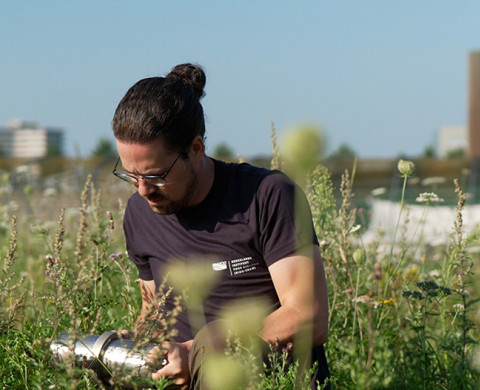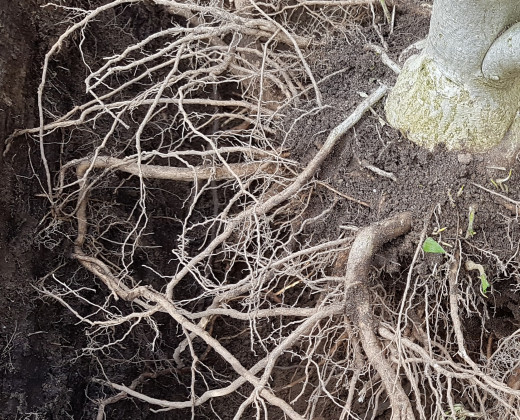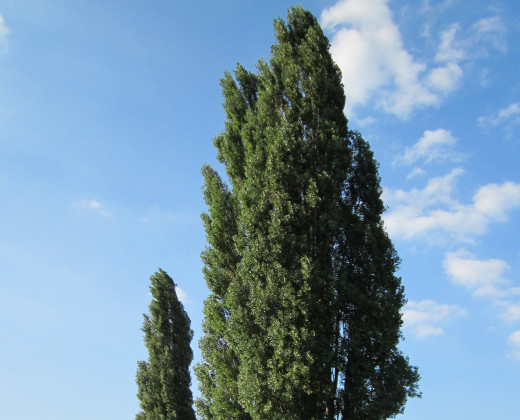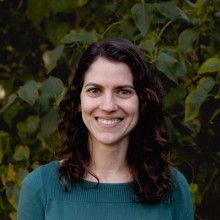Terrestrial Ecology

The department of Terrestrial Ecology studies species, communities and ecosystems in a rapidly changing world.
Due to climate change, land use changes, biological invasions and other environmental disruptions, the natural world is facing unprecedented environmental challenges. Much of our research focuses on plants and the interactions that they have with microbes, insects and other organisms, in the soil and aboveground.
Our mission is to study the impact that these environmental changes have on terrestrial ecosystems and to contribute to measures that safeguard terrestrial ecosystem functioning in the Anthropocene.
How our research helps to understand and mitigate effects of climate change, biodiversity loss and land use change:
- Biodiversity: How is below-ground biodiversity, and the services it provides, affected by management and ecological processes? How can we bend the curve of insect decline? How are belowground and aboveground biodiversity linked?
- Climate change: What is the impact of extreme climatic events on terrestrial ecosystems? How can terrestrial ecosystems function as effective carbon sinks? What is the capacity of species to adapt to rapid environmental change?
- Land use change: How can ecosystem functioning be restored in former agricultural land? How can ecosystem services be improved under agricultural practice?
Biodiversity
Biodiversity in terrestrial ecosystems plays an important role in ecosystem functioning based on the vast array of interactions occurring among individuals, populations and communities across variable spatial and temporal scales. In our department, we study the effects of biotic and abiotic processes on individual- and species-level responses in a broader community-based framework. Biodiversity is not always easily seen. For example, the soil is teeming with biodiversity, and microorganisms and (micro)arthropods found there play crucial roles in food-webs and ecosystem processes such as nutrient cycling and carbon storage. We therefore study belowground biodiversity in various projects across the Netherlands as well as abroad (links to Onder het Maaiveld, Voedselbossen, something international). Given that insects are one of the most species-rich groups of animals, and they play key roles in providing a range of ecological services, we are investigating how changes in land use influence insect diversity and biomass and how we can bend the curve of insect decline. A proposed step in our research is to see how the link between belowground and aboveground biodiversity is affected under concomitant or sequentially occurring climatic extremes as well as under different land-use scenarios.
Climate change
Anthropogenic climate change is exposing terrestrial ecosystems to multiple abiotic stresses over variable spatial and temporal scales. Our research investigates the impact of climate change on organisms, trophic interactions and ecosystem functioning in terrestrial ecosystems. For instance, what is the impact of extreme climate events on organisms? And how do abiotic climate change stresses as interact with other processes that affect ecosystems, such as biological invasions and habitat loss? At the same time, we try to understand how we can let nature help to mitigate impacts of climate change, for instance via promoting carbon storage in soils. Another focus is on understanding the capacity of individual species to adapt to such rapid environmental changes. What are the genetic and epigenetic mechanisms that may facilitate rapid adaptation? Finally, we contribute to raising awareness and evidence-based environmental advocacy – having scientific insights bear on public discussion and on the need for mitigation are vitally important.
Land use change
Use of land is one of the most significant impacts that humans have on Earth’s natural systems. Our activities alter the diversity and distribution of species and the ability of terrestrial ecosystems to serve important functions including storing carbon, cleaning water and supporting plant growth. In TE we research how natural ecosystems can be restored following disturbance by human land use, both with respect to their inherent value as biodiverse ecosystems and their support of valuable functions. Furthermore, TE brings an ecological perspective to contemporary agricultural land use to safeguard these ecosystem functions while supporting food production. An emerging research topic is how urban ecosystems – among the most intensive of human land uses – affects the ecology and evolution of wild species.
Facilities
Plant-soil feedbacks
Plants are crucial mediators of interactions between aboveground- and belowground organisms. We study how plants affect soil microbes, nematodes and arthropods, and how these effects on belowground communities feed back on plants. We apply this knowledge for steering soil communities for ecological restoration. We also investigate how beneficial soil microbes enhance plant resistance and suppress pathogens, which can help improve sustainable agriculture practices.

Carbon storage
We study carbon cycling in terrestrial ecosystems, where soils and plants are important for limiting climate warming. Soil organisms drive decomposition of plant material and stabilise soil carbon, under the influence of plants, viruses, global change and human management. Trees build up carbon stocks in their biomass and affect the soils below. Better understanding of these ecosystem processes supports climate-proof land-use management across agriculture, forests, and rehabilitation of abandoned land.

Ecological genetics and epigenetic
How do plants respond and adapt to their rapidly changing environments? We study the genetic and molecular mechanisms of plant adaptation in habitats with strong human impacts, such as abandoned farmland and cities. One focus is on epigenetic mechanisms, which shape the expression of plant genomes in a dynamic, stable but reversible way. We use genomic analysis in clonal plants such as poplar trees to investigate if this epigenetic flexibility helps plants cope with rapid change.

People
-
Dr. Ciska Veen
- Function
- Head of department

-
Dr. ir. Justine Lejoly
- Function
- Researcher | Tenure Track

-
Dr. Koen Verhoeven
- Function
- Senior Researcher
-
Prof. dr. Liesbeth Bakker
- Function
- Senior Researcher

-
Dr. Camille Delavaux
- Function
- Senior Researcher

-
Ing. Freddy ten Hooven
- Function
- Research assistant

-
Ciska Raaijmakers
- Function
- Research assistant

-
Slavica Milanovic-Ivanovic
- Function
- Laboratory Assistant

-
Ing. Tanja Bakx-Schotman
- Function
- Research assistant

-
Em. Prof. dr. ir. Wim H. van der Putten
- Function
- Researcher

Peer-reviewed publications
Grassland degradation status modulates the relative contribution of soil nematode diversity and community structure to ecosystem functioning under nitrogen fertilization and irrigation management
Long-term diversifying afforestation enhances soil microbial network complexity and stability
Temporal and spatial dynamics of microbial communities and greenhouse gas flux responses to experimental flooding in riparian forest soils
Exposure to high temperatures is fatal for eggs and suppresses growth in a false widow spider, Steatoda grossa
Differential Effects of Nitrogen Chemical Forms on Soil Bacterial Communities and Ecosystem Multifunctionality in a Temperate Meadow Steppe
Forb diversity globally is harmed by nutrient enrichment but can be rescued by large mammalian herbivory
Functional diversity of soil microbial communities increases with ecosystem development
Nematode and protist community responses in soil to land use conversion from conventional to organic farming
Sustainable intensification
Food availability influences adult body mass variability and reproductive traits in a spider
Heterogeneous microcosm mazes affect reproduction and survival in a wingless hyperparasitoid wasp
Long-Term Euxinia Restricts Microbial Methane Removal in Eutrophic Coastal Basins
Drought intensity and duration interact to magnify losses in primary productivity
Drought has short-term effects on soil fungal communities leading to long-term effects on soil functions
Recovery of below-ground associations in restored Brazilian Atlantic Forest
Genetic variation in leaf chemistry driven by herbivory affects phyllosphere fungal communities in an invasive plant
The Bug-Network (BugNet)
Reliability of earthworm data from citizen science
A global database of soil microbial phospholipid fatty acids and enzyme activities
Benchmarking soil multifunctionality
The impact of decomposer size classes and litter quality on litter decomposition in food forests
Agricultural disturbance reduces arbuscular mycorrhizal fungal diversity and biomass by excluding specialist species
The development of insect diversity and ecosystem complexity on green roofs
Two deeply conserved non-coding sequences control PLETHORA1/2 expression and coordinate embryo and root development
Steering plant-soil feedback for sustainable agriculture
Effects of crop species on soil functions and soil multifunctionality are species-specific
Soil lessons from restored atlantic forest
Interactive Effects of Warming and Competition Do Not Limit the Adaptive Plastic Response to Drought in Populations of a Mediterranean Plant
Understanding the effects of organic versus conventional farming on soil organic carbon characteristics
Foliar Herbivory Suppresses Arbuscular Mycorrhizal Colonisation by Weakening Symbiosis Signalling in Root Exudates
Decoupling of plant nitrogen and phosphorus under global change over the last two decades
Priming for seagrass resilience
Development of whole-soil microbial inoculants based on solid-phase fermentation for the regeneration of the functioning of vineyard soils
Nematodes vector bacteriophages in compost and soil
Functional adaptations of the rhizosphere microbiome for drought-tolerance promotion in common bean
Added value of AI for studying urban plants
The role of technology in human-nature connectedness
Local nutrient addition drives plant diversity losses but not biotic homogenization in global grasslands
Microbial scents
Conventional and organic farms with more intensive management have lower soil functionality
Frequent failure of nutrients to increase plant biomass supports the need for precision fertilization in agriculture
Reduced precipitation frequency decreases the stability of the soil organic carbon pool by altering microbial communities in degraded grasslands
gFlora
The applicability of regional red list assessments for soil invertebrates
Microbial Interactions Influence the Chemical Defense of Wild and Cultivated Tomato Species
Non‐random tree species loss shifts soil fungal communities
Bacterial and fungal diversity and species interactions inversely affect ecosystem functions under drought in a semi-arid grassland
Development and reproduction in the synanthropic spiders Steatoda bipunctata and S. triangulosa (Araneae: Theridiidae)
Macroecological rules predict how biomass scales with species richness in nature
Ectomycorrhizal symbiosis evolved independently and by convergent gene duplication in rosid lineages
Ecological genomics beyond genome reports
Grazing intensity by sheep affects spatial diversity in botanical composition of Inner Mongolian grassland
Water level drawdown and perennial vegetation impact litter decomposition in the sediment of a eutrophic wetland in the Netherlands
A pan-European citizen science study shows population size, climate and land use are related to biased morph ratios in the heterostylous plant Primula veris
Interactive and unimodal relationships between plant biomass, abiotic factors, and plant diversity in global grasslands
Bioinoculant-induced plant resistance is modulated by interactions with resident soil microbes
Harnessing the synergy of Urochloa brizantha and Amazonian Dark Earth microbiomes for enhanced pasture recovery
Phylogeography of Antarctic soil invertebrate fauna reveals ancient origins, repeated colonization and recent evolution
Copulation interruption decreases female reproductive success in a false widow spider
Impact of soil inoculation on crop residue breakdown and carbon and nitrogen cycling in organically and conventionally managed agricultural soils
SpeSpeNet
Host size overrides maternal effects on the development of a secondary hyperparasitoid wasp
Herbivore species and patch heterogeneity modulate grazing-induced shifts in soil nematode trophic structure and energy flux
Benchmarking for soil health improvement
Parental environment nitrogen and phosphorus availability affects offspring traits of eight annual plant species
Pre-existing global change legacies regulate the responses of multifunctionality to warming
Drivers of phenotypic variation and plasticity to drought in populations of a Mediterranean shrub along an environmental gradient
Testing ion exchange resin for quantifying bulk and throughfall deposition of macro- and micro-elements in forests
Nature is a maze for geline hyperparasitoids
Soil extracellular enzyme activity increases during the transition from conventional to organic farming
Beneficial soil fungi enhance tomato crop productivity and resistance to the leaf-mining pest Tuta absoluta in agronomic conditions
Zooming in on the temporal dimensions of plant–soil feedback
The effect of biotic and abiotic factors on reproduction in a false widow spider
Iron mineral type controls organic matter stability and priming in paddy soil under anaerobic conditions
The imprint of microbe-induced plant resistance in plant-associated insects
High-resolution methylome analysis uncovers stress-responsive genomic hotspots and drought-sensitive transposable element superfamilies in the clonal Lombardy poplar
Global changes and their environmental stressors have a significant impact on soil biodiversity
Vital soils for sustainable agriculture
Understanding grassland ecosystem responses to different grazing intensities
Typical earthworm assemblages of European ecosystem types
The use of living labs to advance agro-ecological theory in the transition towards sustainable land use
Assessing soil functioning
Enzyme regulation patterns in fungal inoculated wheat may reflect resistance and tolerance towards an insect herbivore
Distance decay effects predominantly shape spider but not carabid community composition in crop fields in north-western Europe
Diana Wall
Root traits and soil legacies drive species competition outcomes
Widening global variability in grassland biomass since the 1980s
Integrating viruses into soil food web biogeochemistry
Molecular Mechanisms of Temperature Tolerance Plasticity in an Arthropod
Earthworm cast microbiomes differ across soil types in northern forests
Normalized difference vegetation index analysis reveals increase of biomass production and stability during the conversion from conventional to organic farming
Some like it hot
Sampling data of macro-invertebrates collected in grasslands under restoration succession in a lowland stream-valley system
Carbon-phosphorus cycle models overestimate CO 2 enrichment response in a mature Eucalyptus forest
Plant Multi-element Coupling as an Indicator of Nutritional Mismatches Under Global Change
Microbial competition for phosphorus limits the CO2 response of a mature forest
Bacterial genomes recovered from litter’s metagenomes in Amazonian Dark Earths
Abandonment of traditional livestock grazing reduces soil fertility and enzyme activity, alters soil microbial communities, and decouples microbial networks, with consequences for forage quality in Mediterranean grasslands
Plant–soil interactions during the native and exotic range expansion of an annual plant
Effects of different soil organic amendments (OAs) on extracellular polymeric substances (EPS)
Unearthing the soil‐borne microbiome of land plants
Distance- and density-dependent recruitment of common ragwort is not driven by plant-soil feedbacks
Fungal communities are passengers in community development of dune ecosystems, while bacteria are not
Vertebrate grazing can mitigateimpacts of nutrient addition on plant diversity and insect abundance in a semi-natural grassland
Soil elemental cycles become more coupled in response to increased nitrogen deposition in a semiarid shrubland
Soil BON Earthworm
The interplay between the inoculation of plant growth-promoting rhizobacteria and the rhizosphere microbiome and their impact on plant phenotype
Depth‐dependent responses of soil organic carbon under nitrogen deposition
Early developmental carry‐over effects on exploratory behaviour and DNA methylation in wild great tits (Parus major)
Testing the impacts of invasive jumping worms at their northern range limit
Reply to: Field experiments show no consistent reductions in soil microbial carbon in response to warming
Arabidopsis in succession






